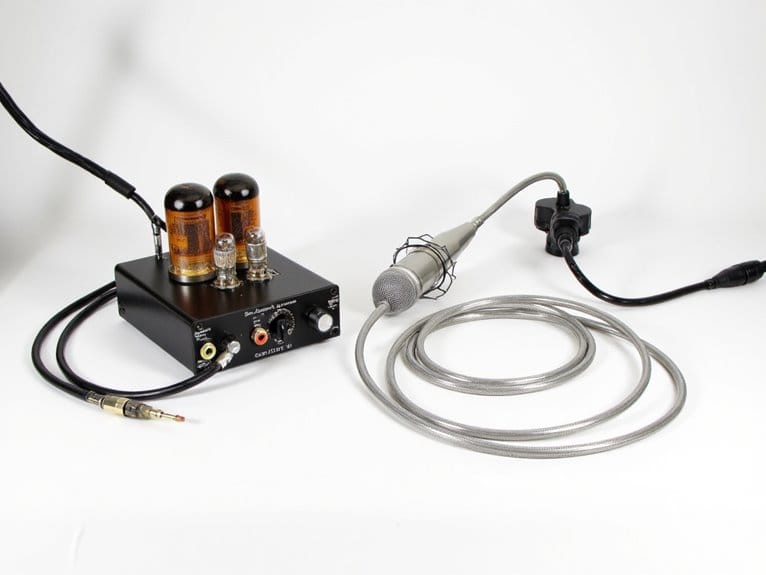Understanding Bass String Gauge and Tension
String gauge and scale length work together to determine your bass’s tension, with thicker strings creating higher tension and longer scales requiring more force to reach pitch. A .105 low E string generates about 34 pounds on short-scale basses but jumps to 45.2 pounds on extra-long instruments. Heavier gauges produce fuller, warmer tones while lighter strings offer brighter sounds and easier playability, though tension varies between brands despite identical gauge numbers. Understanding these relationships helps optimize your instrument’s setup and performance characteristics.
We are supported by our audience. When you purchase through links on our site, we may earn an affiliate commission, at no extra cost for you. Learn more.
Notable Insights
- Thicker string gauges create higher tension, resulting in stiffer feel and fuller, warmer bass tones.
- Scale length significantly impacts tension, with longer scales requiring more tension to reach identical pitches.
- Tension increases proportionally with scale length squared, from 100% baseline at 30″ to 144% at 36″.
- Professional bassists prefer heavier gauges (.105-.130) for richer fundamentals, while lighter gauges emphasize upper harmonics.
- String construction differences between brands affect tension despite identical gauge numbers, requiring neck adjustments when switching.
The Relationship Between String Gauge and Tension
When you’re selecting bass strings, understanding the direct relationship between gauge and tension becomes essential for achieving your desired sound and playability.
Thicker strings produce considerably higher tension when tuned to the same pitch, creating a stiffer feel that requires more finger pressure and effort for bending notes. For gauge comparison purposes, a .105 low E string generates approximately 34 pounds of tension on short-scale basses, while tension metrics show this increases to about 45.2 pounds on extra-long scale instruments.
However, I’ve learned that identical gauge strings can still exhibit tension variations due to core density and manufacturing differences, particularly with electric bass strings, which means you can’t always predict feel based solely on diameter measurements. The tonal characteristics of your strings can also be enhanced by upgrading your bass pickups, which help translate the string vibrations into the electrical signal that shapes your overall sound. Switching between different gauges may require neck adjustments to accommodate the changes in string tension. Manufacturers typically offer balanced string sets designed to provide consistent tension distribution across all strings, addressing the natural variability that occurs when using traditional gauge combinations.
Many bassists also find that using a quality bass preamp helps optimize the signal from different string gauges, ensuring consistent tone quality regardless of the tension variations across different strings. Lighter gauges enable more intricate work while maintaining playability, making them particularly useful for complex fingering patterns and rapid note sequences.
How Scale Length Affects String Tension
When you’re selecting bass strings, you’ll quickly discover that scale length plays an essential role in determining how tight or loose your strings feel under your fingers, directly impacting both playability and tone.
Your bass’s scale length—typically ranging from 30 to 35 inches—affects string tension more dramatically than you might expect, with longer scales requiring considerably more tension to reach the same pitch as shorter scales. Most affordable bass guitars feature a standard 34-inch scale length, which provides familiar string tension characteristics and makes future upgrades more straightforward. Smaller gauge strings are more affected by changes in scale length, meaning incremental adjustments become increasingly important as you move between different bass configurations.
Understanding this relationship between scale length and tension will help you make smarter decisions about string gauge selection, setup adjustments, and ultimately find the perfect balance between comfort and the sound you’re chasing. The body material choice of your bass can also influence how string tension translates into tonal characteristics and sustain.
Scale Length Basics
The relationship between scale length and string tension represents one of the most fundamental yet frequently misunderstood aspects of bass guitar setup, and I’ve found that many players don’t realize how dramatically this single factor affects their instrument’s feel and sound.
When you examine the scale overview, you’ll discover that longer scales require notably more tension to achieve the same pitch compared to shorter instruments using identical strings.
The tuning effects become apparent when you consider that a 34-inch bass feels considerably stiffer than a 30-inch short scale, even with matching string gauges and identical tuning.
This tension difference directly impacts your playing experience, affecting everything from finger comfort to tonal characteristics, making scale length selection essential for your setup preferences.
Tension Across Scales
Although many bassists assume string tension remains constant across different instruments, I’ve discovered through years of testing various scale lengths that tension actually increases proportionally with the square of the scale length when you’re using identical strings tuned to the same pitch. This means your 35-inch scale bass will feel considerably tighter than a 30-inch short scale, even with the same gauge strings.
| Scale Length | Relative Tension |
|---|---|
| 30″ Short Scale | 100% (baseline) |
| 32″ Medium Scale | 114% |
| 34″ Standard Scale | 128% |
| 35″ Long Scale | 136% |
| 36″ Extra Long | 144% |
Understanding this scale comparison helps you make informed tension adjustment decisions when switching between different basses or selecting appropriate string gauges for ideal playability.
Practical Scale Considerations
Since most bassists don’t realize how markedly scale length impacts their playing experience, I’ve spent considerable time testing identical string sets across different scale instruments to demonstrate these practical effects.
When you’re selecting strings, you’ll discover that string length requirements vary notably between 30-inch short scales and 35-inch extended scales, affecting both tension and tone dramatically.
I’ve found that material types respond differently across scale lengths—nickel-wound strings feel noticeably looser on short scales, while stainless steel maintains better tension consistency. The wood materials used in the bass construction also interact with string tension to influence overall resonance and tone depth.
You’ll need heavier gauges on shorter instruments to achieve comparable tension to longer scales, though this creates interesting tonal trade-offs that can actually enhance certain playing styles and musical genres.
Professional players consistently report that higher gauge strings ranging from .105 to .130 produce richer bass-heavy tones on longer scale instruments, though they require more finger strength compared to lighter alternatives.
Light to medium gauge strings in the 40-60 range provide optimal tension and flexibility for techniques requiring responsiveness, particularly when maintaining consistent feel across different scale lengths.
Gauge Impact on Playability and Tone Quality
When you’re choosing bass string gauge, you’ll discover that this single decision dramatically shapes both how your instrument feels under your fingers and the fundamental character of your tone.
Gauge variation creates distinct tonal characteristics, with heavier strings delivering fuller, warmer sounds through enhanced fundamentals and richer overtones, while lighter gauges produce brighter tones emphasizing upper harmonics.
Heavier bass strings produce warmer, fuller tones while lighter gauges emphasize brightness and upper harmonics.
The playability difference becomes immediately apparent—heavier strings increase tension, making fretting and bending more demanding but providing enhanced stability for vibrato and string bends.
Lighter strings offer easier fingerboard response, particularly beneficial for fast fingerstyle techniques and quick articulation. Standard 5-string sets typically range from .045 to .130, with heavier gauges offering more volume and sustain compared to lighter options that facilitate easier bending and intricate melodic work.
This creates an interesting trade-off between tonal richness and physical ease, requiring you to balance your desired sound against your playing style and technical requirements.
Professional bassists often complement their string choice with bass preamp pedals to further shape their tone and achieve the exact sound characteristics they desire in both live and studio settings. Many also incorporate compression pedals into their signal chain to manage the dynamic range differences that naturally occur between various string gauges.
Achieving Balanced Tension Across String Sets
The pursuit of balanced tension represents one of bass playing’s most overlooked yet transformative concepts, where each string maintains roughly equal pounds of tension to create uniformity across your entire fretboard. Achieving this balance requires strategic gauge selection that considers scale length, tuning, and material properties, altering how your bass responds under your fingers.
Modern tension balancing techniques utilize mathematical formulas combining unit weight, scale length, and target pitch to determine ideal gauge combinations. Software calculators like String Tension Pro simplify this process, while custom string formulations allow manufacturers to fine-tune characteristics through material adjustments.
Key benefits include:
- Consistent resistance when plucking or slapping
- Enhanced dynamic control across all strings
- Reduced string noise and buzzing
- Smoother shifts during technical passages
While implementation challenges exist, particularly with alternate tunings, balanced tension sets offer remarkable improvements in playability and comfort.
Tension Variations Between Brands and Construction Types
Understanding balanced tension across your bass strings becomes more complex when you realize that identical gauge numbers don’t guarantee identical tensions between manufacturers, a reality that’s caught me off guard more times than I’d like to admit.
Brand comparisons reveal significant variations—a .013 string shows 27.4 lbs tension in D’Addario versus 25.8 lbs in Curt Mangan when tuned to E, primarily due to different scale length calculations and core materials.
Construction effects prove equally influential, as round core versus hex core designs create varying densities and stiffness characteristics. Professional musicians often rely on premium strings like D’Addario NYXL for their superior tuning stability during extended playing sessions, where consistent tension becomes crucial for performance reliability.
Flatwound strings often feel tighter than roundwounds despite identical gauges, while stainless steel maintains similar tension to nickel but offers increased brightness and grip, making manufacturer-specific tension charts essential for informed string selection. Steel cores provide exceptional tuning stability and projection, which becomes particularly important when switching between different construction types where inconsistent tuning behavior can disrupt performance.
Just as bass recording benefits from professional interfaces with low latency performance, accurate string tension measurements require precise calculations that account for both material properties and manufacturer-specific construction methods.
Frequently Asked Questions
How Often Should I Replace Bass Strings to Maintain Consistent Tension?
You should replace bass strings every 3-4 months for consistent tension and tone. However, string life varies based on playing frequency and preferences. Regular cleaning and proper maintenance tips can extend their lifespan considerably.
Do Flatwound Strings Have Different Tension Characteristics Than Roundwound Strings?
Yes, you’ll notice flatwound tension feels higher than roundwound characteristics due to increased stiffness from their smooth construction. While actual measured tension differences are small, flatwounds feel tighter and resist bending more.
Should I Adjust Pickup Height When Switching to Different String Gauges?
Yes, you should adjust pickup height when switching string gauges. Different gauges affect string vibration patterns and electromagnetic interaction, so proper pickup height guarantees ideal string sound output and prevents buzzing or dampening issues.
On a final note
You’ll find that mastering string gauge and tension relationships transforms your playing experience, though I’ll admit the math can be intimidating at first. By understanding how scale length, construction materials, and brand variations affect tension distribution, you’re equipped to make informed decisions that optimize both playability and tone. Remember, balanced tension across your string set matters more than following arbitrary gauge recommendations from manufacturers.







